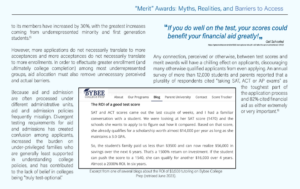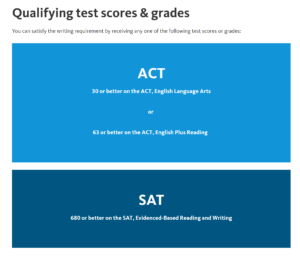What they don’t say about test scores
Updated 21 June 2023
A big “thank you” to FairTest for using a screenshot of this blogpost in their recent research demonstrating that test scores can help students at 96% of institutions.

I don’t think they intended to make the case that test scores can help, but they made an excellent argument that it is true.
Original Blogpost from December 2021
The SAT and ACT are in the news a lot these days. Maybe that’s just my world because of this thing I do. Harvard recently announced that it would not require test scores through at least the class of 2026 and the University of California system seems to remind everyone weekly that they don’t even want to see test scores. They haven’t addressed other things like their “Entry Level Writing Requirement” that still requires a test score to take classes because real-life details about what the student will experience aren’t as sexy as headlines. (More on that later.)

From the UC website – UC minimum requirements to demonstrate writing readiness
Of course, we also have Freddie deBoer’s assessment of the more likely reason Harvard and other selective universities are making these announcements.
The opponents of the SAT and ACT often talk about test-optional admissions policies as if removing test scores from college admissions will be a panacea for the inequities in the process. Spoiler alert – they aren’t. And what gets left out of the conversation is how good test scores can benefit a student in admissions, in placement, and in the pocketbook.
The ROI of a good test score
SAT and ACT scores came out the last couple of weeks, and I had a familiar conversation with a student. We were looking at her SAT score (1470) and the schools she wants to apply to to figure out how it compared. Based on that score, she already qualifies for a scholarship worth almost $14,000 per year as long as she maintains a 3.0 GPA.
So, the student’s family paid us less than $3500 and can now realize $56,000 in savings over the next 6 years. That’s a 1500% return on investment. If the student can push the score to a 1540, she can qualify for another $16,000 over 4 years. Almost a 2000% ROI. In six years.

Automatic out of state tuition waivers at Oklahoma State
The scores don’t have to be top 5% to qualify for great – and automatic – merit aid. Oklahoma State University has an automatic tuition waiver that offers out-of-state applicants $10,000 a year if they have a 3.0 GPA and an 1160 SAT or 24 ACT. The best a student will get with GPA only is $8,000 a year with a minimum 3.75. An 1160 is literally worth $8,000 more than a 4.0 high school GPA at Oklahoma State.
More than merit aid
It’s not just students making exceptional scores who stand to benefit. Many states have requirements of certain test scores for students to take freshman classes. Texas requires students to demonstrate college readiness before they can take classes for college credit. Students can show college readiness in a number of ways, but the easiest is SAT or ACT scores. They only need a 1010 with 530 RW and 480 Math to qualify.
Again, we go back to ROI. If the student can’t demonstrate college readiness, they have to take “developmental” classes which do not count for credit. The “developmental” classes amount to about 9 hours. If the average cost per hour is $400, that’s $3,600 and it doesn’t include the costs of adding almost another full semester’s worth of classes to your graduation plan, to say nothing of room and board expenses.
Our Test Prep Boot Camp, which is one of the more expensive classes around, costs $1,295. One student we worked with last year applied to a university in Oklahoma without submitting his test score. When he got ready to enroll in classes, they told him he would be taking the developmental classes because they didn’t have a test score for him. He had a test score (which he probably should have submitted to begin with) and was immediately able to sign up for classes that would actually count toward his degree. The $1,295 they spent on the class immediately saved the family $4,000.
And then there’s academic placement
When talking about test-optional policies, admissions offices often leave out that the scores can be used for academic placement. Make no mistake: admissions offices have carefully worded their policies. Here’s a glimpse at the statement from the UC system.
UC will not consider SAT or ACT test scores when making admissions decisions or awarding scholarships. If you choose to submit test scores as part of your application, they may be used as an alternative method of fulfilling minimum requirements for eligibility or for course placement after you enroll.
Scores won’t be used when making admissions decisions. Cool. But you can STILL choose to submit scores if you want. I mean, they might help after you enroll.
Buried in the UC website is information on their “Entry Level Writing Requirement”. Presumably it’s something you’ll find out when you want to enroll in classes. It isn’t something you’re going to find surfing around the admissions pages. (I found it by searching “university of california academic placement” because I knew to look for such things.) Like the requirements in Texas and Oklahoma, the requirement can be satisfied by a number of different measures like IB or AP scores. One significant difference is that California’s requirement is much higher – a minimum 680 SAT Reading and Writing (at least for UCLA, Berkeley, Merced, Riverside, and San Diego).
So, the UC system is grabbing headlines making it clear that admissions decisions won’t require test scores. They’re making it less clear that without some qualifying measure you’re either not enrolling at one of the above campuses or you’re not taking freshman level classes when you get there.
Removing objectivity
People portray exceptional test scores as the province of only those who can afford expensive test prep. They cite studies that show a correlation between affluence and high test scores. You know what else correlates with affluence and test scores? Just about everything.
But test scores are the only part of the process that does give an objective assessment of what the student is capable of independent of a specific school’s grading patterns, GPA system, IB and AP availability, and a host of other variables. Test scores demonstrate what a student can do on a test at a specific time. The tests are like getting on a scale to find out your weight. You might not like what the scale tells you, but that number isn’t the scale’s fault.
The “soft” parts of applications
After test scores and GPA, the other elements of an application are more malleable. Essays aren’t objective. Will you get a reader who likes your particular essay? Is your essay one of the first they’ve read, later in the admissions cycle, toward the end? What glass of wine are they on when they read it? To what extent was it written by the student versus a small coterie of cooks in the kitchen like parents and essay counselors or entirely written by Write-My-College-Essay.com.
Letters of recommendation? Nope. Will the person writing your letter of recommendation use just the right words to trigger the right rating? A 2018 article from the Harvard Crimson had a detailed analysis about how the admissions process worked at the time. Presumably everything, probably including the test scores, are relatively the same. It’s not like Harvard has seen fewer applications since the Spring of 2020. The Crimson article described how admissions evaluates letters of recommendation.
Finally, in a section titled “School Support,” the reading procedures outline how admissions officers should rank letters of recommendation penned by teachers and guidance counselors. If a letter writer describes the student as “the best of a career” or “one of the best in many years,” that student is likely to earn a 1. If, however, the applicant is merely “one of the best” or “the best this year,” they are more likely to score a 2.
The Crimson article captures how the “holistic” process works. Admissions offices promote holistic processes as some sort of way to quantify applications objectively, but they evaluate each individual piece in subjective ways.
Information asymmetry
It’s difficult to find out exactly how colleges make their decisions. Admissions officers might strive for transparency, but in the end they have knowledge that it just doesn’t help them to share because they know how crazy parents and students can get with that information. If the Ivies suggested the best way to get admitted was to help indigenous people in Guatemala, half of the applicants would be immediately booking flights for the next summer and the other half would be coming up with ways to make it look like they did.
The best plan is to stick to what we know (still) works. Get the best test scores you can. Take the toughest classes you can and make the best grades you can in those classes. Pursue outside interests that fill your heart with joy, not for the sake of the “college resume”. When you submit your application, have confidence in the fact that you’ve done the best you can with the things you control and be satisfied with the outcome.









